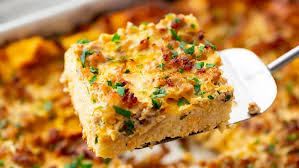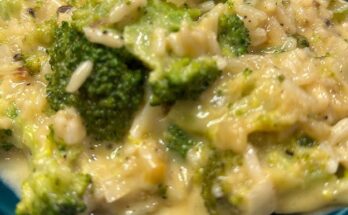Breakfast Egg Casserole Recipe: A breakfast egg casserole is a warm, hearty dish made by combining beaten eggs with various ingredients like cheese, vegetables, meats, and bread or potatoes. It’s baked in a casserole dish until it’s puffed and golden, creating a rich, savory meal that’s perfect for feeding a crowd or preparing in advance for busy mornings. Think of it as a delicious mashup of an omelet and a frittata, but baked instead of fried. It’s a one-dish wonder that doesn’t require flipping or fussing—just mix, bake, and enjoy.
What makes this dish especially loved is its flexibility. You can toss in leftover veggies, use different kinds of meats, and get creative with spices and cheeses. It’s equally perfect for holidays, brunch get-togethers, or everyday breakfasts when you want something filling without spending all morning in the kitchen.
Why It’s a Breakfast Favorite
Why do people love breakfast egg casseroles so much? Well, for starters, they’re easy to make in large batches, which is a lifesaver when hosting guests. They’re also super forgiving—forget to add something? No problem. Want to throw in something new? Go for it. And since it all comes together in one baking dish, cleanup is a breeze.
Another major win: you can prepare it the night before. Just pop it in the oven in the morning, and breakfast is served. Plus, the combination of protein from the eggs and other ingredients keeps you full for hours. Whether you’re trying to eat healthier or just love a comforting morning meal, this recipe ticks all the boxes.
Essential Ingredients for a Perfect Egg Casserole
Core Ingredients You’ll Need
Let’s break down what you’ll need for the base version of a breakfast egg casserole:
- Eggs (8–10 large): These are the foundation. Use fresh eggs for the best texture and flavor.
- Milk or Cream (1–1.5 cups): Adds richness and helps the eggs bake evenly.
- Cheese (1–2 cups shredded): Cheddar, mozzarella, pepper jack—choose what you love.
- Vegetables (1–2 cups chopped): Onions, bell peppers, spinach, and mushrooms are popular.
- Protein (1–2 cups cooked): Think sausage, bacon, ham, or even leftover chicken.
- Bread or Potatoes (optional, 2 cups): Day-old bread cubes or hash browns give structure and body.
These core ingredients are enough to make a satisfying casserole, but the real magic happens when you start customizing it to suit your taste or pantry.
Optional Add-ins for Extra Flavor
Want to level up your casserole? Here are some delicious extras to consider:
- Herbs & Spices: A pinch of garlic powder, paprika, or fresh herbs like parsley or chives.
- Hot Sauce or Mustard: Add a subtle kick and complexity.
- Sour Cream or Cream Cheese: Stir into the egg mix for a richer texture.
- Sun-Dried Tomatoes or Roasted Red Peppers: Bring bold flavor without extra moisture.
- Zucchini or Kale: These greens add nutrition and bulk without overpowering the dish.
These add-ins aren’t just for flavor—they also help tailor the dish to your dietary needs, whether you’re going low-carb, vegetarian, or high-protein.
Step-by-Step Instructions
Step 1: Preparing the Ingredients
Before diving into assembly, get all your ingredients prepped and ready. Here’s how:
- Preheat the oven to 350°F (175°C). Grease a 9×13-inch baking dish with butter or non-stick spray.
- Cook your proteins. If using sausage or bacon, cook it in a skillet until browned and crisp. Drain excess grease.
- Chop the vegetables. Dice onions, bell peppers, and any other veggies you’re using. Sauté if needed to soften them and enhance flavor.
- Grate the cheese. Freshly grated cheese melts better than pre-shredded.
- Whisk the eggs. In a large bowl, whisk together the eggs and milk (or cream). Add a pinch of salt and pepper.
- Optional: If using bread or hash browns, place them at the bottom of the baking dish as a layer.
Once everything is ready, you’re just a few minutes away from getting it in the oven.
Step 2: Assembling the Casserole
This is where all the ingredients come together:
- Layer the base (if using bread or potatoes): Spread evenly on the bottom of your dish.
- Add the meat and vegetables: Scatter them over the base.
- Sprinkle the cheese: Reserve a little for the top.
- Pour the egg mixture: Slowly pour the whisked eggs over everything. Tilt the dish to ensure it covers evenly.
- Top with remaining cheese: This creates a golden crust on top.
Let it sit for about 5–10 minutes before baking if you have time—this helps the eggs soak into the bread or hash browns for a better texture.
Step 3: Baking to Perfection
Now for the final step:
- Bake uncovered for 45–55 minutes. Check doneness by inserting a knife in the center—it should come out clean.
- Let it rest for 5–10 minutes before cutting. This helps it set and makes serving easier.
You’ll know it’s done when it’s golden brown on top and slightly puffed. The inside should be moist but fully set—not runny.
Tips for the Best Results
Make-Ahead Tips
One of the biggest perks of a breakfast egg casserole is how well it lends itself to prepping ahead of time. Whether you’re hosting brunch or just want to streamline your morning routine, here’s how to do it:
- Assemble the Night Before: You can completely assemble your casserole the night before. Cover it tightly with plastic wrap or foil and store it in the fridge. This not only saves time in the morning but allows the flavors to meld together beautifully.
- Bring to Room Temperature: Before baking, let the casserole sit on the counter for about 20–30 minutes. This ensures even baking and prevents a cold center.
- Freezing Instructions: Want to make it even further in advance? Freeze the unbaked casserole for up to 2 months. Wrap it well with both plastic wrap and foil. Thaw overnight in the fridge before baking as usual.
Making it ahead is a total game-changer, especially during holidays or when you have guests. You get all the flavor and comfort without the early morning scramble.
Substitutions and Variations
This recipe is incredibly flexible, making it easy to adapt based on dietary needs, preferences, or what you have in your kitchen. Here are some great swaps and variations:
- Dairy-Free: Use plant-based milk like almond or oat milk and skip the cheese or use dairy-free alternatives.
- Gluten-Free: Skip the bread or use gluten-free bread. Hash browns also make a great base.
- Low-Carb/Keto: Eliminate bread and potatoes altogether. Focus on eggs, cheese, meats, and low-carb veggies like spinach, mushrooms, and peppers.
- Vegetarian: Omit meats and pile in more veggies like zucchini, broccoli, tomatoes, and onions.
- Different Cheeses: Mix and match cheeses—try Swiss, feta, gouda, or pepper jack for added kick.
Want to get fancy? Add caramelized onions, crumbled goat cheese, or even a drizzle of pesto before baking. There’s really no wrong way to customize your casserole—just follow your taste buds.
Serving and Storage Suggestions
What to Serve With Egg Casserole
A breakfast egg casserole is hearty enough to stand alone, but if you’re putting together a full spread, here are some tasty sides that complement it perfectly:
- Fresh Fruit Salad: A refreshing balance to the richness of the casserole.
- Toast or Biscuits: Great for soaking up extra flavors on the plate.
- Green Salad: If serving for brunch or lunch, a simple salad adds freshness.
- Breakfast Potatoes: If your casserole doesn’t already include them.
- Yogurt Parfaits or Muffins: Offer something light and sweet for contrast.
And of course, don’t forget coffee, orange juice, or even mimosas if it’s a special occasion. A little garnish of fresh herbs on the casserole also adds a nice visual touch.
Storing and Reheating Leftovers
Don’t worry if you end up with leftovers—this casserole stores like a dream and tastes just as good reheated. Here’s how:
- Refrigeration: Store leftovers in an airtight container in the fridge for up to 4 days.
- Freezing Leftovers: Cut the casserole into portions and wrap each piece in plastic wrap and foil. Freeze for up to 2 months.
- Reheating: Microwave individual slices for about 1–2 minutes or reheat in a 350°F oven for 15–20 minutes, covered with foil to prevent drying out.
Casserole leftovers are fantastic for a quick breakfast, lunch, or even dinner. You can also crumble them into a tortilla for a quick breakfast burrito or serve with a side salad for a lighter meal.
Common Mistakes to Avoid
Overbaking the Casserole
One of the most frequent mistakes with breakfast egg casseroles is overbaking. When eggs are overcooked, they become rubbery and dry, which ruins the comforting, custardy texture we’re aiming for. To avoid this:
- Check early: Start checking your casserole around the 45-minute mark. Insert a knife or toothpick in the center—it should come out clean but moist.
- Cover if browning too fast: If the top is browning too quickly but the center isn’t done yet, loosely cover it with foil.
- Let it rest: Even if it looks slightly soft in the center, it’ll continue to cook from residual heat as it sits out for a few minutes post-baking.
The goal is a golden, firm-but-tender casserole, not a dry, tough brick of eggs.
Not Draining Excess Moisture
Whether it’s from sautéed vegetables or cooked sausage, moisture is the enemy of a firm casserole. Too much liquid can make your casserole watery and prevent it from setting properly.
Here’s how to fix that:
- Cook off moisture: Always sauté high-water-content veggies like mushrooms, spinach, or zucchini until most of the liquid is evaporated.
- Drain meats: Bacon, sausage, and ground meats should be cooked and drained thoroughly.
- Use day-old bread: If you’re using bread, stale or toasted bread is better—it soaks up the eggs without becoming soggy.
A few extra minutes of prep go a long way in ensuring your casserole has the perfect structure.
Creative Variations to Try
Mexican-Style Egg Casserole
Want to spice things up? Go south of the border with this vibrant variation:
- Ingredients: Add chorizo, black beans, chopped green chilies, and pepper jack cheese.
- Spices: Sprinkle in cumin, chili powder, and a dash of cayenne.
- Toppings: Serve with salsa, sour cream, avocado slices, and fresh cilantro.
It’s colorful, flavorful, and adds a zesty kick to your morning.
Mediterranean-Inspired Casserole
For a lighter, fresher version packed with flavor, try this:
- Ingredients: Use spinach, sun-dried tomatoes, feta cheese, and olives.
- Protein: Swap meat for chickpeas or keep it vegetarian.
- Flavor Profile: Add oregano, garlic, and a squeeze of lemon juice before baking.
This variation feels fancy but is just as easy to prep and bake.
Sweet Breakfast Casserole (Yes, Really!)
Switch things up completely by going sweet instead of savory:
- Base: Use cinnamon raisin bread or croissants.
- Filling: Mix eggs with milk, sugar, vanilla extract, and a touch of cinnamon.
- Add-ins: Add berries, apples, or even chocolate chips.
This makes for a delightful breakfast dessert or a special weekend treat—like French toast casserole with a twist.
Why You’ll Love Making This Recipe
Let’s face it—breakfast can be a stressful time of day, especially if you’re feeding a crowd or rushing to get out the door. But a breakfast egg casserole solves so many problems:
- It’s one-dish magic: No need to juggle pans or flip omelets.
- Feeds everyone at once: You’re not stuck playing short-order cook.
- Flexible and foolproof: Use what you’ve got and make it your own.
- Perfect for meal prep: Make it ahead, portion it out, and you’re set for the week.
It’s the kind of recipe that once you try it, it becomes a staple in your kitchen routine. Whether it’s for a holiday morning, a Sunday brunch, or just because—it never disappoints.
FAQs about Breakfast Egg Casserole Recipe
1. Can I make breakfast egg casserole without bread or potatoes?
Absolutely! Just skip them for a low-carb version and add more veggies or meat for structure.
2. How long can I store leftovers in the fridge?
Leftovers will stay fresh for up to 4 days when stored in an airtight container.
3. Can I freeze an egg casserole after baking it?
Yes! Let it cool completely, then wrap portions tightly and freeze for up to 2 months.
4. What’s the best cheese for breakfast casseroles?
Cheddar, mozzarella, Swiss, and pepper jack are great options. Mix and match for more flavor.
5. Can I cook it in a muffin tin for individual portions?
Definitely! Just reduce the baking time to about 20–25 minutes and grease the tins well.
Conclusion
A breakfast egg casserole is more than just eggs baked in a dish—it’s a versatile, family-friendly, crowd-pleasing meal that’s as easy to customize as it is to prepare. With just a few staple ingredients and a little bit of planning, you can whip up a breakfast that’s nourishing, satisfying, and downright delicious.
From classic meat-and-cheese versions to creative takes with international flair, the possibilities are endless. So next time you’re wondering what to make for breakfast, skip the scramble and go straight for the casserole dish.



